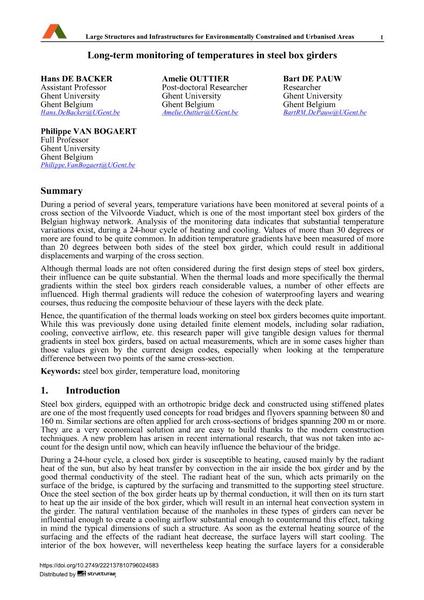Long-term monitoring of temperatures in steel box girders

|
|
|||||||||||
Bibliografische Angaben
| Autor(en): |
Hans De Backer
Amelie Outtier Bart De Pauw Philippe Van Bogaert |
||||
|---|---|---|---|---|---|
| Medium: | Tagungsbeitrag | ||||
| Sprache(n): | Englisch | ||||
| Tagung: | IABSE Symposium: Large Structures and Infrastructures for Environmentally Constrained and Urbanised Areas, Venice, Italy, 22-24 September 2010 | ||||
| Veröffentlicht in: | IABSE Symposium Venice 2010 | ||||
|
|||||
| Seite(n): | 270-271 | ||||
| Anzahl der Seiten (im PDF): | 8 | ||||
| Jahr: | 2010 | ||||
| DOI: | 10.2749/222137810796024583 | ||||
| Abstrakt: |
During a period of several years, temperature variations have been monitored at several points of a cross section of the Vilvoorde Viaduct, which is one of the most important steel box girders of the Belgian highway network. Analysis of the monitoring data indicates that substantial temperature variations exist, during a 24-hour cycle of heating and cooling. Values of more than 30 degrees or more are found to be quite common. In addition temperature gradients have been measured of more than 20 degrees between both sides of the steel box girder, which could result in additional displacements and warping of the cross section. Although thermal loads are not often considered during the first design steps of steel box girders, their influence can be quite substantial. When the thermal loads and more specifically the thermal gradients within the steel box girders reach considerable values, a number of other effects are influenced. High thermal gradients will reduce the cohesion of waterproofing layers and wearing courses, thus reducing the composite behaviour of these layers with the deck plate. Hence, the quantification of the thermal loads working on steel box girders becomes quite important. While this was previously done using detailed finite element models, including solar radiation, cooling, convective airflow, etc. this research paper will give tangible design values for thermal gradients in steel box girders, based on actual measurements, which are in some cases higher than those values given by the current design codes, especially when looking at the temperature difference between two points of the same cross-section. |
||||
| Stichwörter: |
Stahlhohlkästen Monitoring
|
||||
